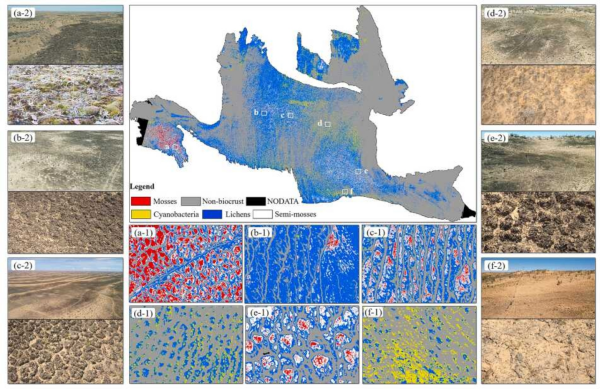XIEG, BNU Map Biological Soil Crusts in Gurbantunggut Desert, China
2024-09-19
As a type of land covers in arid regions, biological soil crusts play a crucial ecological role in stabilizing land surfaces, enhancing hydrological processes, and promoting nutrient cycling. The spectral characteristics of biological soil crusts can be significantly changed by snowmelt, making it possible to distinguish biological crusts from other components.
A research team led by Prof. CHEN Jin from Beijing Normal University (BNU), and Prof. ZHANG Yuanming from the Xinjiang Institute of Ecology and Geography (XIEG) of the Chinese Academy of Sciences, analyzed the spectral responses of biological soil crusts to snowmelt events in early spring.
They employed high-temporal (1-day) and high-spatial (3-meter) resolution images from the PlanetScope satellite constellation and used a two-stage framework for mapping biocrust succession. The mapping framework achieved overall accuracies of 0.958 and 0.802 for Stage I and Stage II, respectively. This indicates the framework's ability to delineate spatial patterns of different successional stages across landscape and regional scales. They found that cyanobacteria and lichens dominate expansive areas of the Gurbantunggut Desert, while semi-mosses are more prevalent in the central and southeastern parts of the desert.
The study was published online with the title "Mapping the successional stages of biological soil crusts at 3-m resolution in the Gurbantunggut Desert, China, through hydration-induced spectral response" in the Remote Sensing of Environment. It can provide a basis for understanding the growth and development of desert crusts and lay a foundation for further exploration of desert ecosystem structure, ecosystem services, and the impacts of climate change and human activities.
Article link: https://www.sciencedirect.com/science/article/pii/S0034425724002487

Spatial distribution of biological soil crusts at different successional stages in the Gurbantunggut Desert
Contact
LONG Huaping
Xinjiang Institute of Ecology and Geography
E-mail: longhp@ms.xjb.ac.cn
Web: http://english.egi.cas.cn



